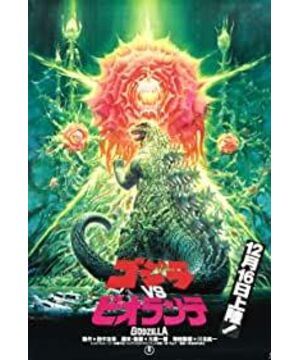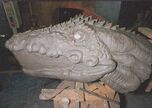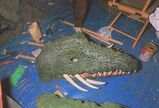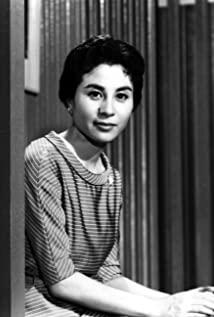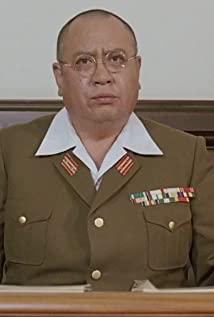Looking at the title, I didn't expect to be party to the title. I was originally looking forward to a Godzilla fight with joy, but I didn't expect to see a Godzilla fight against the magic flower with a logical plot that was not too past. Dare to love Biolanti is the false Godzilla among the true and false Godzillas. . .
One of the biggest problems with this film is that there are too many stakeholders: the protagonist doctor, the American company, the Middle East government, the Japanese government military, the Japanese domestic biological foundation, and the beautiful girl who can talk to Godzilla and flowers. . There is not too much crossover between the clues of all stakeholders, so most of the time in this film, they are talking to themselves, especially in the first half of the film, there is no clear logical line. Including the protagonist, the US company, and the Middle East government, their intentions and goals are very vague. Although a group of people are fighting for the Godzilla sample organization, the reasons for fighting are not very clear.
The most funny thing is that American companies, if they can test pressure through diplomatic channels, why should they send spies to do some unpretentious things in the first place? . .
And Godzilla hurriedly appeared in this chaotic plot layout and the occasional oolong of humans fighting each other.
Generally speaking, Godzilla must have a stronger purpose when he wakes up, either for defeating Gidola, or for some other monster. But this time Godzilla lacks a very clear goal. Therefore, the Godzilla in this film is ambiguous about the two choices of eating (via Nagoya) or fighting Bioranti.
At first, Godzilla woke up and marched towards Japan, and then after being blocked by the Self-Defense Forces for the first time, he turned his head and confronted the Bioranti flower beast. After successfully destroying the opponent, he began to attack Nagoya’s nuclear power plant. The factory advances, and in the meantime, it constantly resists human harassment by force. Although the whole process is full of the passion of monster wars, it feels a bit inexplicable. The most important point is, why did Godzilla fight Biolanti? The two sides are far apart, and Bioranti has not violated Godzilla in any way.
Biolanti is the most powerful opponent in the Godzilla series. There is no strength, no skill, no scheming, just forcefulness, and there is nothing more than open mouth and death entanglement. Except for his huge body, he didn't have any abilities to make people's eyes shine, and the vitals of his chest flashed with light, as if it would be attacked. Therefore, during the first duel, Godzilla was hit by a cannon and died. And when it evolved into a more fearful form in the second stage, it was easily repelled by Godzilla's breath, and the entire battle time was less than five minutes. . .
In the end, the way Godzilla was dealt with was: Biolandi turned into an ion to activate Godzilla's nuclear-eating bacteria. . . Hehehehe, if Godzilla is an elephant, the bacteria is a mouse, and Bioranti's role is equivalent to the roar of gongs and drums and the sound of firecrackers, awakening the sleeping mouse.
After going around for a long time, it turns out that Biolandi is the positive character. If there is no Wan Zun of the last battle, I really haven't found Biolandi originally belonged to the human camp. Obviously this monster's face is not very kind (especially in its final form), and it cannibalize.
A basic logic of Japanese science fiction and special photos is that for any crazy monster, there must be a crazy scientist behind it. The scientist in this film is also a fighter in the best. Combine the DNA of your daughter with the DNA of Rose and Godzilla to create a Biolandi. Not only did he choose the name of the monster in advance (to prove that he had an expectation for the appearance of the monster), he also watched like a okay person during the battle between Bioranti and Godzilla, and there was nothing to let his daughter into the soil for peace. Feeling sad, but also plausible with his own scientific research. . . Fortunately, the scientist was killed at the end of the film. Otherwise, there might be monsters like Biolanti II. . .
Compared with the radical style of scientists, the performance of the human army on Godzilla is still not worth mentioning. The special fighters boasted at the beginning did not have the expected effect, and the army equipped with weapons and teeth did not cause any real harm to Godzilla (the final effect was the little girl who eats nuclear bacteria and mental communication), but it has always been The boss of the foundation, who is obsessed with the commercialization of Godzilla cell tissue, impressed me deeply, and it embodies the characteristics of capitalists who are profit-oriented. You really dare to make any money.
The value and connotation of the film is to face up to the effect of the double-edged sword of science from a human perspective, and the portrayal of Godzilla is also expressed in a more objective and force majeure natural direction. These two points are a very innovative theme and progress in both the black and white Showa special film and even the world's science fiction films at that time. Godzilla actually continued this theme in 91 years, except that Biolanti was replaced by a mechanical Gidola, and the purpose was the same. . .
View more about Godzilla vs. Biollante reviews


